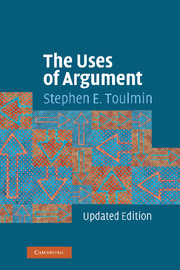Book contents
- Frontmatter
- Contents
- Preface to the Updated Edition
- Preface to the Paperback Edition
- Preface to the First Edition
- Introduction
- I Fields of Argument and Modals
- II Probability
- III The Layout of Arguments
- IV Working Logic and Idealised Logic
- V The Origins of Epistemological Theory
- Conclusion
- References
- Index
III - The Layout of Arguments
Published online by Cambridge University Press: 05 June 2012
- Frontmatter
- Contents
- Preface to the Updated Edition
- Preface to the Paperback Edition
- Preface to the First Edition
- Introduction
- I Fields of Argument and Modals
- II Probability
- III The Layout of Arguments
- IV Working Logic and Idealised Logic
- V The Origins of Epistemological Theory
- Conclusion
- References
- Index
Summary
An argument is like an organism. It has both a gross, anatomical structure and a finer, as-it-were physiological one. When set out explicitly in all its detail, it may occupy a number of printed pages or take perhaps a quarter of an hour to deliver; and within this time or space one can distinguish the main phases marking the progress of the argument from the initial statement of an unsettled problem to the final presentation of a conclusion. These main phases will each of them occupy some minutes or paragraphs, and represent the chief anatomical units of the argument—its ‘organs’, so to speak. But within each paragraph, when one gets down to the level of individual sentences, a finer structure can be recognised, and this is the structure with which logicians have mainly concerned themselves. It is at this physiological level that the idea of logical form has been introduced, and here that the validity of our arguments has ultimately to be established or refuted.
The time has come to change the focus of our inquiry, and to concentrate on this finer level. Yet we cannot afford to forget what we have learned by our study of the grosser anatomy of arguments, for here as with organisms the detailed physiology proves most intelligible when expounded against a background of coarser anatomical distinctions.
- Type
- Chapter
- Information
- The Uses of Argument , pp. 87 - 134Publisher: Cambridge University PressPrint publication year: 2003
- 8
- Cited by



